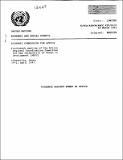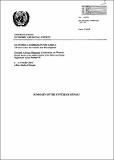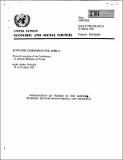Violence against women in Africa

View
Download
Published
1993-03Author(s)/Corporate Author (s)
United Nations. Economic and Social Council;United Nations. Economic Commission for Africa;
Metadata
Show full item recordAbstract
The available research on violence against women1 concludes that this problem is a reality in African societies and families and that it is spreading. it is necessary to underline that research of the issue in African countries is far from being comprehensive. Some of the studies manage only to touch upon the problem of violence against women and, as a rule, limit themselves to the analysis of certain aspects of the issue such as legal remedies for the victims and sanctions against the offenders for some of the most common forms of violent offenses. Among such studies one can mention a series on "The Law and the Status of Women" in the Central African Republic, Ghana, Morocco, the United Republic of Tanzania and Zaire carried out by the ECA African Training and Research Centre for Women (ATRCW). Some other studies address only specific types or forms of violence against women as, for example, Egyptian and Nigerian studies on "Women Assaulted in the Family" or "A Study of Rape in Swaziland" in the series "Women and Law in Southern Africa". These studies are based on official information available in police stations, courts, clinics and social welfare organizations which is far from being complete for the purpose of comprehensive research of the problem.
Citation
“United Nations. Economic and Social Council; United Nations. Economic Commission for Africa (1993-03). Violence against women in Africa. UN. ECA Africa Regional Coordinationg Committee for the Integration of Women in Development (ARCC) (14th : 1993, April, 19-21 : Libreville, Gabon). Libreville :. © UN. ECA,. https://hdl.handle.net/10855/926”Conference
UN. ECA Africa Regional Coordinationg Committee for the Integration of Women in Development (ARCC) (14th : 1993, April, 19-21 : Libreville, Gabon)Collections
- Gender [2556]
Related items
Showing items related by title, author, creator and subject.
Summary of the synthesis report
United Nations. Economic and Social Council; United Nations. Economic Commission for Africa. African Centre for Gender and Development
“United Nations. Economic and Social Council; United Nations. Economic Commission for Africa. African Centre for Gender and Development (2004-08). Summary of the synthesis report. UN. ECA African Regional Conference on Women : Decade Review of the Implementation of the Dakar and Beijing Platform for Action (Beijing+10) (7th : 2004, Oct. 6-14 : Addis Ababa, Ethiopia); UN. ECA African Regional Conference on Women : Decade Review of the Implementation of the Dakar and Beijing Platform for Action (Beijing+10) (7th : 2004, Oct. 6-14 : Addis Ababa, Ethiopia). Addis Ababa :. © UN. ECA,. https://hdl.handle.net/10855/14409”
Integration of women in the modern business sector, both formal and informal
United Nations. Economic and Social Council; United Nations. Economic Commission for Africa
“United Nations. Economic and Social Council; United Nations. Economic Commission for Africa (1991-03). Integration of women in the modern business sector, both formal and informal. UN. ECA Conference of African Ministers of Trade (11th : 1990, April, 15 - 19 : Addis Ababa, Ethiopia). Addis Ababa :. © UN. ECA,. https://hdl.handle.net/10855/12285”
Comparative study of national laws on the rights and status of women in Africa
United Nations. Economic and Social Council; United Nations. Economic and Social Council; United Nations. Economic Commission for Africa.
“United Nations. Economic and Social Council; United Nations. Economic and Social Council; United Nations. Economic Commission for Africa. (1990-03). Comparative study of national laws on the rights and status of women in Africa. UN. ECA African Regional Coordinating Committee for the Integration of Women in Development Meeting (11th : 1990, Mar. 06-08: Tripoli, the Great Socialist People's Libyan Arab Jamahiriya).. Addis Ababa :. © UN. ECA,. https://hdl.handle.net/10855/26537”



